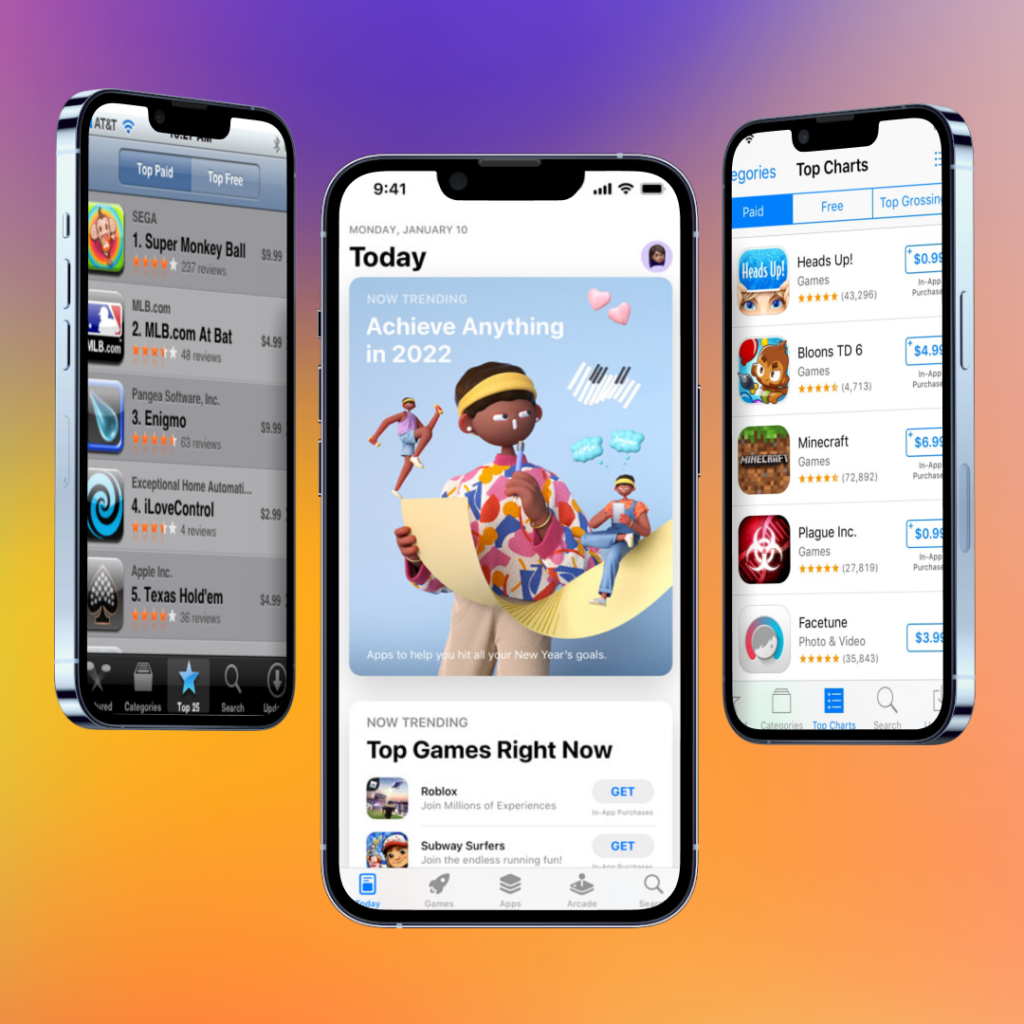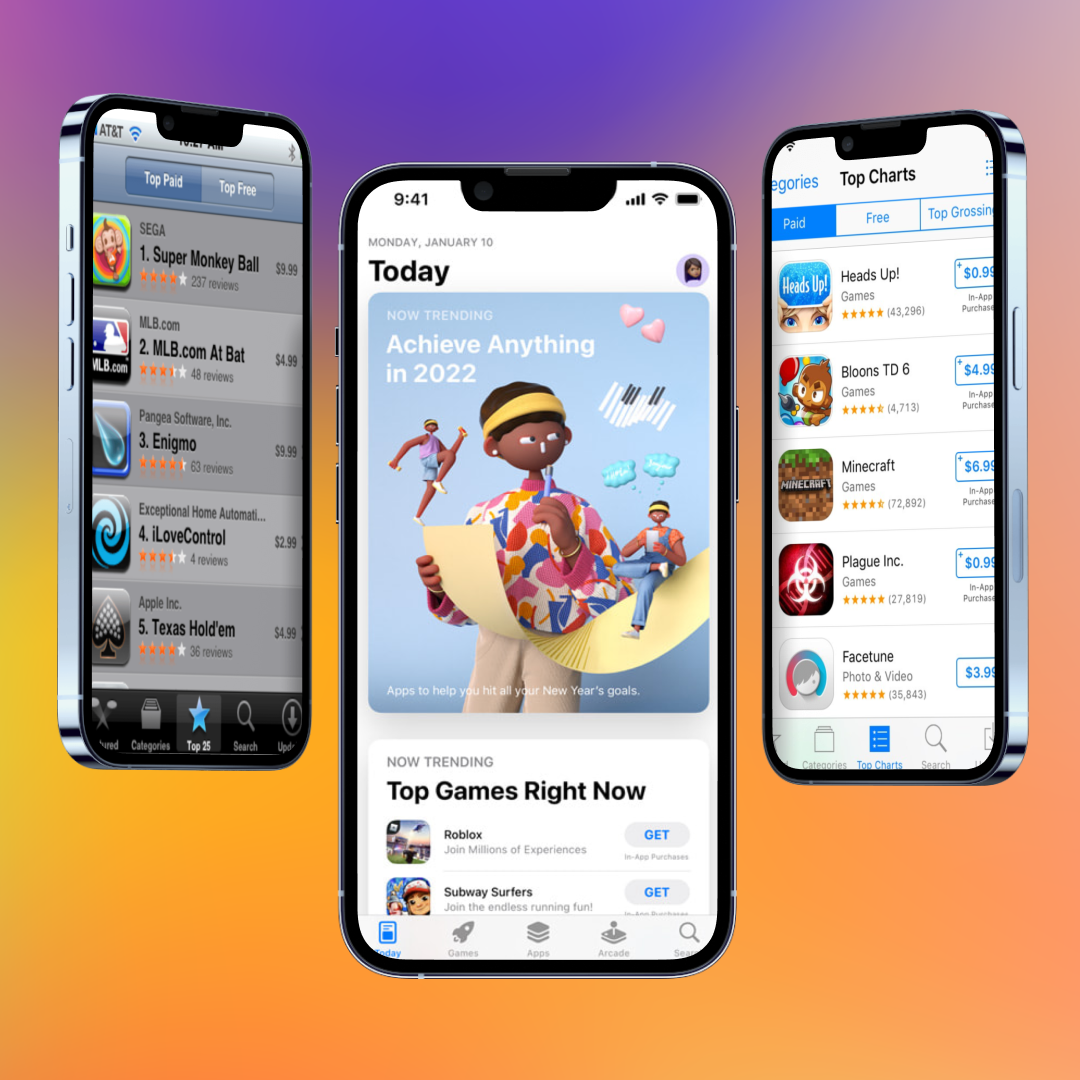
The first mobile apps launched in the 2000s. They were fairly simple – Calendar, Phone Book and others. Then, as the operating systems improved, the functions of the applications became more complex, and at the same time the competition between developers grew and the ways of promoting mobile applications evolved.
What stages did mobile app marketing go through before becoming what we know it to be today?
Stage 1. The emergence of the first mobile app marketplace
App marketing was born with mobile app stores. In 2007, Apple released the first generation of iPhones on iOS. In 2008, the App Store appeared, offering users 552 programs for download. Before that, only vendors could install software on the device through firmware updates. Just 9 months after its launch, the App Store reached 1 billion downloads.
Following Apple in 2008, Google launched the first smartphone based on Android in partnership with mobile device manufacturers (Samsung and LG), and with it, the App Store counterpart, Android Market, was released. In 2009 the Android Market introduced the first opportunity for developers to make money from their apps, initially only in the US and UK, but a year later in 27 more countries. That was also when Google saw its first billion downloads. In 2011 Android OS became the most widely used operating system in the world.
Within three years the biggest revolution in mobile development took place: there was a steady demand for apps, a distribution system was formed and new ways to monetise them.
Almost the same promotion methods were used for mobile apps as for any other product: TV commercials and publications in the printed press, contextual advertising in search engines, banner advertising on relevant websites, SEO, and viral marketing.

Initially, the success criterion of the new product developers considered a high CTR – “clicks means there is interest”. However, the clicks did not always lead to a direct instal, which means they did not bring revenue. As a result, the main indicator of effectiveness was the number of users attracted. The more users who downloaded the app, the higher its rating in app stores. Thus the operating system stores themselves became the basic platform for promoting apps.
Gradually the notion of ASO (App Store Optimisation) was formed, a set of principles and methods to promote mobile games and apps in the App Store and Play Market. According to the developers of Angry Birds, launched in 2009 and soon to be a worldwide franchise, they didn’t spend a dime to promote the app. The game promoted itself once it hit the AppStore. Within the first two months the number of downloads reached 2 million and by the end of 2010 reached 50 million, of which about 12 million downloads were in the $1-paid versions.
Stage 2. Changing the app promotion strategy
In 2012, app ads appeared on Fb’s mobile version. From then on, social networks became one of the most popular platforms for promotion. That same year, Google rebranded Android Market to Google Play. At that time, Google Play did not yet have pre- and post-moderation mechanisms – only the total number of downloads mattered.
By 2015, the approach to evaluating the effectiveness of app marketing gradually began to change: multiple downloads were no longer the main priority and marketers focused on a more mature strategy – attracting loyal users. For example, an app that operates on the freemium model offers customers a free installation and is monetised through in-app purchases. Thus, the return on investment (ROI) will depend not on the number of installations, but on the “quality” of users who install the app.
Thus mobile app developers began to focus on customers with high lifetime value (LTV) – active users who spend and (ideally) will spend real money within the app, and marketing strategies have also refocused on them. Cross-promotion became a priority, which allows you to use your existing (or already lost) customer base with a high LTV to promote new projects.
Stage 3. Crisis
The promotion of mobile games and programs was considered relatively simple – you just have to make a colourful creative, upload it to your social media advertising cabinet, choose the right audience and excellent results were not long in coming.
Advertising on Google was divided into three sources of traffic: search, YouTube, and contextual-media networks (or banner ads). And while the first two sites worked well, the contextual media network was awful. Banner advertising in context media network gave results several times worse than the same YouTube and even less so search, and therefore advertisers simply did not want to run their campaigns in context media network.
At that time, Google invented the Universal App Campaigns, a format that allowed the marketer to enter only information about the app being promoted, its country, and text, while a clever algorithm would do the rest. Previously, advertisers could set up precise targeting by the audience, category, keyword targeting, and so on, but now the almighty machine learning algorithm was solving everything for them, which focused on the conversions that had already been done. This was presented under the guise of “taking care of users”, but in reality, it was reduced to the trivial, almost forced purchase of Google’s context media network.
The app stores also got a boost. Google Play began checking for malware and terms of service violations before publishing, introduced a regional ranking system, and when ranking search queries began to take into account the number of deletions, retention of 1-7 days, the number of crashes and freezes of the app – now poor-quality apps no longer make it to the top of search results. And Apple has finally allowed US developers to purchase advertising space on the App Store.
Over time, the App Store and Google Play ceased to be the only app stores – phone companies started making their stores: the Xiaomi Store (Mi Store), and the Huawei App Gallery. As a result, users spent $101 billion on app stores in 2018 – 75% more than in 2016. The market value of companies targeting the mobile market rose by an average of 360% in 2018.
Stage 4. It all works!
As the number of smartphone users grows, so does the competition among mobile games and apps for the user’s attention. Marketers have to get creative and expand their advertising arsenal. They use push notifications, teaser and CPA networks, offline advertisement, thematic forums and sites, mailing lists, promo codes, cross-promotional contests, digital, influencer marketing, and many other promo tools. Among them:
- Streaming. Youtube and Twitch have become major companions of young people’s leisure time, and therefore real-time advertising has proven to be a great way to quickly build up a new audience.
- Messengers. Today it is one of the most popular channels of communication with customers. Not only has it overtaken social networks in efficiency, but also attracts mainly targeted (mobile) traffic.
- Blogs. This method shows good results only if you have an untwisted web resource with a large fan base. Integrating a blog with an app website can kill two birds with one stone by combining two ways of the promo: an enticing article about a product + a link to its page.
- Influencer marketing. By enlisting the support of influential bloggers or opinion leaders in your niche, the app’s visibility will increase several times over. This was a great trick to use during the app’s debut launch when the number of instals needs to be as high as possible.
Stage 5. Current Situation. The evolution of the subscription model
Like any other industry, mobile app marketing has changed since the COVID-19 outbreak in 2020. According to AppsFlyer, overall download growth in 2020 was 33% – a 25% increase over 2019. Here are a few trends that will shape this market over the next two years:
- Installation costs are rising by the day.
- The boom of non-gaming apps. 2020 has taught people around the world to do everything from their smartphone screens. All non-gaming apps except the travel category showed multiple growths.
- Subscription model. Subscription model revenue grew 56% in 2020 and will continue to grow. This is due to an increase in the volume of content consumed by users and the popularity of subscriptions to services from the categories “Health and Fitness”, “Education” and “Dating”, which users actively downloaded during the quarantine.
- Hypercasual games. Hyper-casual mobile games have shown dramatic growth since 2021.
We hope an overview of the history of mobile app promotion has not only helped you learn more but has also given you fresh ideas.




